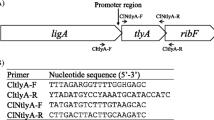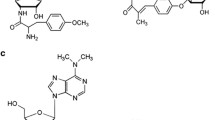Abstract
Clostridium perfringens possesses two sialidase isoenzymes of different molecular weight. Almost 90% of the gene encoding the ‘large’ form was found on a 3.1 kb chromosomal fragment (Sau3AI) of strain A99 by hybridization with probes developed from the N-terminal protein sequence and from commonly conserved sialidase motifs (‘Asp-boxes’), whereas the remaining 3′-terminal part was detected on a 2.1 kb fragment (Hind III) of chromosomal DNA. After combination of both fragments, the resultingE. coli clones expressed sialidase activity, the properties of the recombinant sialidase corresponding with those of the wild type enzyme. The entire chromosomal fragment of 3665 bp encompasses the complete sialidase gene of 2082 bp corresponding to 694 amino aids, from which a molecular weight of 72956 for the mature protein can be deduced. The first 41 amino acids are mostly hydrophobic and probably represent a signal peptide. The sialidase structural gene follows a non-coding region with an inverted repeat and a ribosome-binding site. Upstream from the regulatory region, another open reading frame (ORF) was detected. The 3′-terminus of the sialidase structural gene is directly followed by a further ORF of unknown function, which possibly encodes a putative permease or the acylneuraminate pyruvate-lyase involved in sialic acid catabolism. The primary structure of the ‘large’ isoenzyme is very similar to the sialidase ofClostridium septicum (55% identical amino acids), whereas the homology with the ‘small’ form of the same species is comparatively low (26%).
Similar content being viewed by others
References
Schauer R (1983) InStructural Carbohydrates in the Liver (Popper H, Reutter W, Köttgen E, Gudat F, eds) pp. 83–97. Boston:MTP Press.
Corfield AP, Lambré CR, Michalski J-C, Schauer R (1992)Conferences Philippe Laudat 1991, pp. 111–34. Paris:INSERM.
Müller HE (1992)Bioforum 1/2:16–21.
Godoy VG, Miller Dallas M, Russo TA, Malamy MH (1993)Infect Immun 61:4415–26.
Engstler M, Reuter G, Schauer R (1993)Mol Biochem Parasitol 61:1–14.
Roggentin T, Kleineidam RG, Majewski DM, Tirpitz D, Roggentin P, Schauer R (1993a)J Immunol Meth 157:125–33.
Roggentin P, Schauer R (1993) InGenetics and Molecular Biology of Anaerobic Bacteria (Sebald M, ed) pp. 290–300. New York:Brock/Springer.
Roggentin P, Kleineidam RG, Schauer R (1992a)BioEngineering 2:25.
Nees S, Veh R, Schauer R (1975)Hoppe-Seylers Z Physiol Chem 356:1027–42.
Nees S, Schauer R, Mayer F, Ehrlich K (1976)Hoppe-Seylers Z Physiol Chem 357:839–53.
Nees S, Schauer R (1974)Behring Inst Mitt 55:68–78.
Roggentin P, Schauer R, Hoyer LL, Vimr ER (1993b)Mol Microbiol 9:915–21.
Roggentin P, Rothe B, Lottspeich F, Schauer R (1998a)FEBS Lett 238:314.
Messing J (1983)Methods Enzymol 101:20–78.
Yanisch-Perron C, Vieira J, Messing J (1985)Gene 33:103–19.
Marmur J (1961)J Mol Biol 3:208–18.
Gebers R, Wehmeyer U, Roggentin T, Schlesner H, Kölbel-Boelke J, Hirsch P (1985)Int J Syst Bacteriol 35:260–69.
Sambrook J, Fritsch EF, Maniatis T (1989)Molecular Cloning — A Laboratory Manual Cold Spring Harbor, New York:Cold Spring Harbor Laboratory Press.
Eckerskorn C, Mewes W, Goretzki H, Lottspeich F (1988)Europ J Biochem 176:509–19.
Roggentin P, Rothe B, Kaper JB, Galen J, Lawrisuk L, Vimr ER, Schauer R (1989)Glycoconjugate J 6:349–53.
Southern EM (1975)J Mol Biol 98:503–17.
Davis LG, Dibner MD, Battey JF (1986) InMethods in Molecular Biology, pp 227–29, New York:Elsevier.
Rothe B, Roggentin P, Frank R, Blöcker H, Schauer R (1989)J Gen Microbiol 135:3087–96.
Wallace RB, Johnson MJ, Hirose T, Miyake T, Kawashima EH, Itakura K (1981)Nucl Acids Res 9:879–94.
Sanger F, Nicklen S, Coulson AR (1977)Proc Natl Acad Sci USA 74:5463–67.
Anderberg MR (1973)Cluster Analysis for Applications. New York:Academic Press.
Roggentin P, Gutschker-Gdaniec GHM, Hobrecht R, Schauer R (1988b)Clin Chim Acta 173:251–62.
Schauer R, Sander-Wewer M, Gutschker-Gdaniec GHM, Roggentin P, Randow EA, Hobrecht R (1985)Clin Chim Acta 146:119–27.
Rothe B, Rothe B, Roggentin P, Schauer R (1991)Mol Gen Genetics 226:190–97.
Henningsen M, Roggentin P, Schauer R (1991)Biol Chem Hoppe-Seyler 372:1065–72.
Cato EP, George WL, Finegold SM (1986) InBergey's Manual of Systematic Bacteriology (Snealth PHA, Mair NS, Sharpe ME, Holt JG, eds), Vol. 2, pp. 1141–200. Baltimore:Williams & Wilkins.
Hoyer LL, Hamilton AC, Steenbergen SM, Vimr ER (1992)Mol Microbiol 6:873–84.
Roggentin T, Kleineidam RG, Schauer R, Roggentin P (1992b)Glycoconjugate J 9:235–40.
Dorsch M (1990)Ein Beitrag zur Physlogenie der Grampositiven Eubakterien. Kiel: Dissertation.
Guo X, Sinnott ML (1993)Biochem J 296:291–92.
Vimr ER, Troy FA (1985a)J Bacteriol 164:845–53.
Vimr ER, Troy FA (1985b)J Bacteriol 164:854–60.
Ohta Y, Watanabe K, Kimura A (1985)Nucl Acids Res 13:8843–52.
Canard B, Cole ST (1990)FEMS Microbiol Lett 66:323–26.
Author information
Authors and Affiliations
Rights and permissions
About this article
Cite this article
Traving, C., Schauer, R. & Roggentin, P. Gene structure of the ‘large’ sialidase isoenzyme fromClostridium perfringens A99 and its relationship with other clostridialnanH proteins. Glycoconjugate J 11, 141–151 (1994). https://doi.org/10.1007/BF00731154
Received:
Revised:
Issue Date:
DOI: https://doi.org/10.1007/BF00731154




